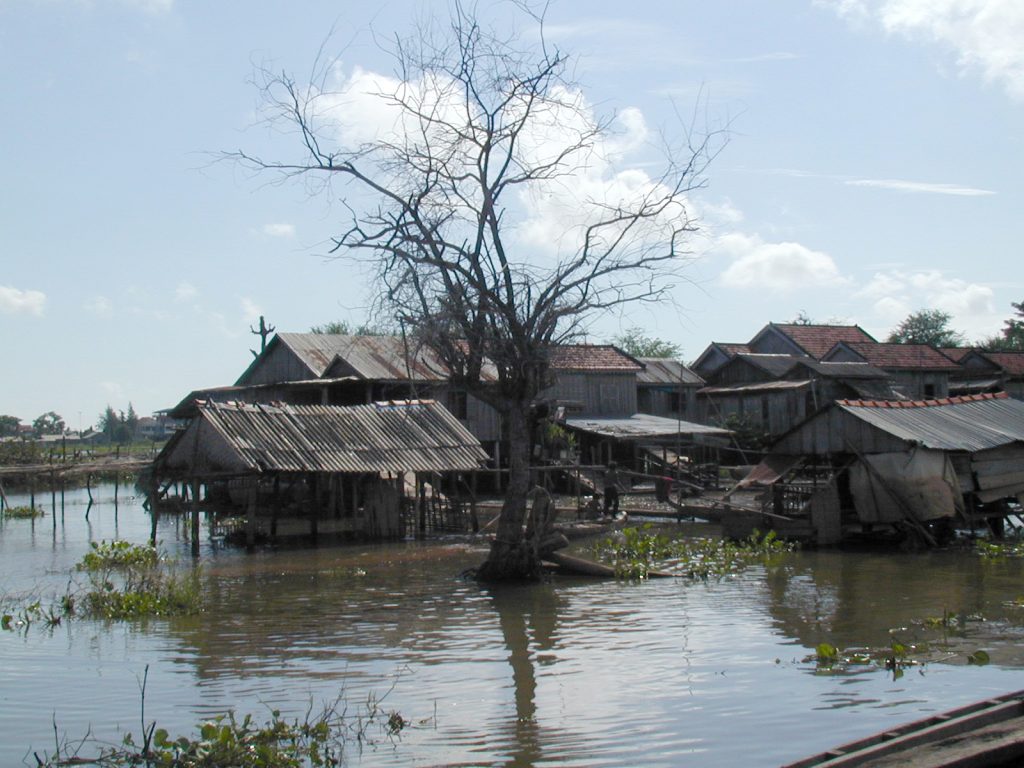គ្រោះទឹកជំនន់និងគ្រោះរាំងស្ងួតជាគ្រោះមហន្តរាយដែលប៉ះពាល់ដល់ប្រជាជនច្រើនជាងគេនៅក្នុងប្រទេសកម្ពុជា ដែលជានិច្ចកាលគ្រោះថ្នាក់ទាំងនេះរមែងនាំឱ្យមានការចំណាយខ្ពស់ជាងគេផងដែរ។ ការផ្លាស់ប្តូរអាកាសធាតុនឹងធ្វើឱ្យស្ថានភាពនេះកាន់តែលំបាក ដោយរដូវប្រាំងមានអាកាសធាតុកាន់តែក្តៅហួតហែង និងរដូវវស្សាមានភ្លៀងធ្លាក់ជោគជាំនិងខ្យល់ព្យុះកាន់តែខ្លាំង។

តំបន់លិចទឹកនៅក្នុងប្រទេសកម្ពុជា, រូបភាព ថតដោយ Adelia Ribier, នៅថ្ងៃទី ២៤ តុលា ២០០១. ក្រោមអាជ្ញាប័ណ្ណ៖ CC BY-NC-ND 2.0
ការរាតត្បាតនៃជម្ងឺក៏អាចនឹងមានផលប៉ះពាល់ទៅកាន់ប្រជាពលរដ្ឋជាច្រើននាក់ផងដែរ បើទោះបីជាការគម្រាមកំហែងពីប្រភេទជម្ងឺ SARSនិងជម្ងឺផ្តាសាយបក្សីក្នុងពេលថ្មីៗនេះ មិននាំឱ្យមានផលប៉ះពាល់ខ្លាំងទៅកាន់ប្រជាពលរដ្ឋក្នុងចំនួនច្រើនក៏ដោយ។
គ្រោះទឹកជំនន់
នៅក្នុងប្រទេសកម្ពុជាមានតំបន់ជាច្រើនគួរឱ្យកត់សម្គាល់ដែលជាប្រភេទតំបន់លិចទឹក ហើយទឹកជំនន់ទៅលើតំបន់ទាំងនេះតែងតែកើតមានឡើងជារៀងរាល់ឆ្នាំនៅក្នុងរដូវវស្សា(ចន្លោះពីខែឧសភាដល់ខែតុលា)។ បាតុភូតនេះនាំឱ្យមានគុណប្រយោជន៏ជាច្រើន តួរយ៉ាងផ្តល់សំណើមនិងជីរជាតិដី ជួយដល់ការស្តុកទឹកលើដីនិងទឹកក្រោមដី និងផ្តល់គុណប្រយោជន៍មួយចំនួនទៀតទៅកាន់វិស័យជលផល។
យ៉ាងណាមិញ ទឹកជំនន់ជោគជាំនាំឱ្យមានបញ្ហាធ្ងន់ធ្ងរ។ គណៈកម្មាធិការជាតិគ្រប់គ្រងគ្រោះមហន្តរាយ(NCDM) បានប៉ានប្រមាណថា ទឹកជំនន់ក្នុងឆ្នាំ២០១៣បានធ្វើឱ្យមានការខាតបង់ទៅកាន់វិស័យកសិកម្ម ហេដ្ឋារចនាសម្ព័ន្ធនិងលំនៅដ្ឋានប្រជាជនក្នុងទឹកប្រាក់ច្រើនជាង៣៥៥លានដុល្លារ។1 គណៈកម្មាធិការដដែលបានរាយការណ៍ថាទឹកជំនន់នេះបានប៉ះពាល់ដល់ប្រជាជនចំនួន ៣៧៧,៣៥៤គ្រួសារនិងប្រជាពលរដ្ឋប្រមាណ ១.៨លាននាក់ក្នុងខេត្តចំនួន២០។ ទឹកជំនន់បានសម្លាប់មនុស្សអស់ចំនួន១៦៨នាក់ ដែលក្នុងនោះភាគច្រើនជាកុមារ។2
ក្នុងករណីគ្រោះទឹកជំនន់ដែលធ្ងន់ធ្ងរបំផុត សេវាសាធារណៈដូចជាវិស័យអប់រំនិងការថែទាំសុខភាពមិនអាចដំណើរការទៅបានយ៉ាងប្រក្រតីនោះទេ។3 ហេដ្ឋារចនាសម្ព័ន្ធ ផ្លូវថ្នល់ ទឹកស្អាតនិងប្រព័ន្ធធារាសាស្ត្រ ព្រមទាំងការចែកចាយអគ្គីសនី(ទៅកាន់កន្លែងដែលអាចទៅដល់)ត្រូវបានខូចខាតឬរងការបំផ្លិចបំផ្លាញ ដែលនេះជាទម្ងន់បន្ថែមលើផលប៉ះពាល់រយៈពេលវែង។ ការធ្លាក់ចុះនៃទិន្នផលវិស័យកសិកម្មបន្ទាប់ពីទឹកជំនន់ក្នុងឆ្នាំ២០១៣ត្រូវបានប៉ានស្មានថានឹងកាត់បន្ថយកំណើនទិន្នផលក្នុងស្រុកសរុប(GDP)របស់កម្ពុជាច្រើនជាង០.៥ភាគរយ។4
ទឹកជំនន់ក្នុងឆ្នាំ២០០០បានប៉ះពាល់ដល់ប្រជាជនចំនួន ៣.៥លាននាក់ រួមមាន ៨៥,០០០គ្រួសារ(ស្មើរនឹងប្រជាជន ៣៨៧,០០០នាក់) បានធ្វើការផ្លាស់ទីបណ្តោះអាសន្នពីគេហដ្ឋាននិងភូមិរបស់ពួកគេ។ មានការស្លាប់ប្រមាណ ៣៤៧ករណី និងផលប៉ះពាល់សរុបទៅកាន់ហេដ្ឋារចនាសម្ព័ន្ធរូបវ័ន្តក្នុងទឹកប្រាក់ប៉ានប្រមាណ ១៥០លានដុល្លារ។5
គ្រោះមហន្តរាយដូចជាគ្រោះទឹកជំនន់មិនមានផលប៉ះពាល់ទៅកាន់ប្រជាជនគ្រប់រូបដូចគ្នានោះទេ។ ជនដែលស្ថិតក្នុងស្ថានភាពគម្រាមកំហែងឬរងផលប៉ះពាល់ច្រើនជាងគេរួមមាន ពលករធ្វើការតាមរដូវ អ្នកស្រែចំការ កុមារ (ដែលភាគច្រើនជាអ្នកស្លាប់ដោយគ្រោះទឹកជំនន់) មនុស្សវ័យចំណាស់ គ្រួសារក្រីក្រលំបាកឬគ្រួសារជាប់បំណុលនិងគ្រួសារដែលដឹកនាំដោយស្ត្រី។
ករណីស្លាប់ដោយសារខ្យល់ព្យុះនិងរន្ទះបាញ់
ខណៈពេលដែលមានករណីគ្រោះមហន្តរាយផ្ទួនគ្នាពីខ្យល់ព្យុះនិងគ្រោះទឹកជំនន់ ខ្យល់ព្យុះអាចនឹងបង្កឱ្យមានការខូចខាតជាក់លាក់មួយចំនួនដូចជា ការខូចខាតទៅលើទីលំនៅរបស់ប្រជាជនដោយសារខ្យល់កន្ត្រាក់ខ្លាំងនិងភ្លៀង ក៏ដូចជាការស្លាប់ដោយសាររន្ទះបាញ់។
ក្នុងរយៈពេល៦សប្តាហ៍គិតចាប់ពីដើមខែមេសា ឆ្នាំ២០១៦ ខ្យល់ព្យុះនៅក្នុងប្រទេសកម្ពុជាបានសម្លាប់ប្រជាជនអស់៥នាក់និងបង្កររបួសស្នាមចំនួន៥៩នាក់ បំផ្លាញទីលំនៅអស់៣៥៧ខ្នងនិងបានប៉ះពាល់ដល់មនុស្សចំនួន ១,៨៨៩នាក់។ 6ក្នុងករណីមួយចំនួន ដំបូលផ្ទះបានប៊ើងចេញពីអាគារ ទៅសង្កត់ត្រូវប្រជាជន។ ក្នុងករណីភ្លៀងធ្លាក់ជោគជាំបានបង្កឱ្យលំនៅដ្ឋានដួលរលំនិងបង្ករបួសស្នាមដល់ប្រជាជនដែលស្ថិតនៅខាងក្នុងលំនៅដ្ឋានទាំងនោះ។
រន្ទះបាញ់បានសម្លាប់មនុស្សចំនួន១០៧នាក់ក្នុងឆ្នាំ២០១៥ និងបង្ករបួសស្នាមដល់មនុស្សចំនួន៧៧នាក់។ នេះជាកំណើនគួរឱ្យកត់សម្គាល់ពីឆ្នាំ២០១៤ ដោយមានប្រជាជនចំនួន៧៥នាក់ត្រូវបានស្លាប់និង៥៥នាក់ទៀតបានរងរបួស។7 ភាពខុសគ្នាពីមួយឆ្នាំទៅមួយឆ្នាំនេះត្រូវបានបន្ទោសទៅលើវត្តមាននៃវន្តធម្មជាតិរបស់បាតុភូត El Niño ក្នុងឆ្នាំ២០១៥។ កម្រិតអ្នកស្លាប់ដោយសាររន្ទះបាញ់ជាមធ្យមនៅទូទាំងប្រទេសកម្ពុជាត្រូវបានប៉ានប្រមាណក្នុងតួរលេខ ៧.៨ក្នុងចំណោមប្រជាជន១លាននាក់ ដែលជាកម្រិតនៃការស្លាប់ខ្ពស់បំផុតក្នុងចំណោមការស្លាប់ដោយសាររន្ទះបាញ់នៅទូទាំងពិភពលោក។ 8ទន្ទឹមនឹងនេះ មានប្រជាជនប្រមាណ៥ ឬ ៦នាក់និងច្រើនជាងនេះដែលអាចនឹងស្លាប់ដោយសារបាតុភូតនេះក្នុងរយៈពេល១សប្តាហ៍។9
រន្ទះបាញ់ក៏អាចមានផលប៉ះពាល់ទៅដល់ទ្រព្យធននិងសត្វចិញ្ចឹមផងដែរ។ ក្នុងឆ្នាំ២០១៥ គេហដ្ឋានចំនួន៩ខ្នងត្រូវបានបំផ្លិចបំផ្លាញយ៉ាងតំណំដោយសាររន្ទះបាញ់ និងធ្វើឱ្យសត្វគោប្រមាណ៤០ក្បាលរងគ្រោះថ្នាក់ ។10
គ្រោះរាំងស្ងួត
គ្រោះរាំងស្ងួតជាគ្រោះថ្នាក់ទីពីរបន្ទាប់ពីគ្រោះទឹកជំនន់ដែលបង្កផលប៉ះពាល់និងការបំផ្លិចបំផ្លាញច្រើនជាងគេ។ គ្រោះរាំងស្ងួតបង្កឡើងដោយសារការខកខាននៃរដូវវស្សា ឬរដូវវស្សាដែលមានរយៈពេលខ្លី និងមានសភាពមិនប្រក្រតី ឬមានកម្រិតទឹកភ្លៀងធ្លាក់ទាបជាងកម្រិតទឹកភ្លៀងមធ្យមសរុប។ គ្រោះរាំងស្ងួតកម្រិតធ្ងន់ធ្ងរប្រចាំសតវត្សនេះ កើតមានឡើងក្នុងឆ្នាំ២០០២ ២០០៣ ២០០៤ (ជាគ្រោះរាំងស្ងួតដែលមានរយៈពេលវែងជាងគេនិងបង្កគ្រោះមហន្តរាយខ្លាំងជាងគេរហូតដល់ឆ្នាំ២០០៦) ឆ្នាំ២០០៦ និងឆ្នាំ២០១៦។ គ្រោះរាំងស្ងួតក្នុងឆ្នាំ២០១៦ត្រូវបានចាត់ទុកជាគ្រោះរាំងស្ងួតដែលមានសភាពធ្ងន់ធ្ងរជាងគេក្នុងចំណោមទសវត្សជាច្រើនកន្លងទៅ និងមានផលប៉ះពាល់ស្ទើរគ្រប់ទីកន្លែងទាំងអស់នៃផ្ទៃប្រទេស។ ឧទាហរណ៍ ក្នុងខែមីនា ឆ្នាំ២០១៦ កម្រិតទឹកទន្លេមេគង្គត្រូវបានធ្លាក់ចុះប្រមាណ ៣០-៥០ភាគរយជាងកម្រិតមធ្យមរបស់វាក្នុងរយៈពេលដដែលនៃឆ្នាំនោះ។11 ក្នុងខែឧសភា ឆ្នាំ២០១៦ គណៈកម្មាធិការជាតិគ្រប់គ្រងគ្រោះមហន្តរាយ(NCDM)បានឱ្យដឹងថា មានប្រជាជនចំនួន ២.៥លាននាក់ដែលបានទទួលរងគ្រោះដោយផ្ទាល់ពីគ្រោះរាំងស្ងួត។12
ការផ្លាស់ប្តូរអាកាសធាតុ
ទិន្នន័យឧតុនិយមបានបង្ហាញថា មានការផ្លាស់ប្តូរចំពោះភាពទៀងទាត់នៃពេលវេលានិងកម្រិតកើតមានរបស់រដូវប្រាំងនិងរដូវវស្សា ដោយរដូវប្រាំងមានរយៈពេលកាន់តែយូរនិងកាន់តែក្តៅហួតហែង ខណៈរដូវវស្សាមានរយៈពេលកាន់តែខ្លីនិងមានភ្លៀងធ្លាក់កាន់តែជោគជាំជាងមុន។ ការផ្លាស់ប្តូរនេះនាំឱ្យមានទឹកជំនន់និងគ្រោះរាំងស្ងួតកាន់តែញឹកញយនិងធ្ងន់ធ្ងរជាងមុន។13
ការផ្លាស់ប្តូរលំនាំអាកាសធាតុនឹងនាំឱ្យមានផលប៉ះពាល់ជាច្រើនទៅលើវិស័យកសិកម្មនិងធនធានជលផល ជាមួយការគម្រាមកំហែងដល់សុវត្ថិភាពស្បៀងអាហារនិងទឹកប្រើប្រាស់។
ការរាតត្បាតនៃជម្ងឺ
ការគម្រាមកំហែងពីការរាតត្បាតនៃជម្ងឺមកលើប្រទេសកម្ពុជាត្រូវបានរំពឹងទុកថានឹងមានកំណើន ដោយអាចសន្និដ្ឋានបានតាមរយៈនគរូបនីយកម្ម ការផ្លាស់ប្តូរអាកាសធាតុ កំណើនភ្ញៀវទេសចរនិងការលេចឡើងនៃជម្ងឺថ្មីៗឬជម្ងឺកាចសាហាវ ។
ជម្ងឺមួយចំនួនដូចជាជម្ងឺគ្រុនឈាមកំពុងមានការកើនឡើង ខណៈការគម្រាមកំហែងពីជម្ងឺប្រភេទផ្សេងៗទៀត តួយ៉ាងដូចប្រភេទជម្ងឺសារ (SARS) ក្នុងឆ្នាំ២០០២ មានការកើនឡើងនិងធ្លាក់ចុះមិនឋិតថេរ។
ជម្ងឺផ្តាសាយបក្សីត្រូវបានរកឃើញដំបូងគេបង្អស់ក្នុងចំណោមបសុបក្សីក្នុងប្រទេសកម្ពុជានៅខែមករាឆ្នាំ២០០៤ និងរកឃើញករណីអ្នកជម្ងឺជាមនុស្សដំបូងក្នុងខែមករាឆ្នាំ២០០៥។ 14តាំងពីពេលនោះមក ប្រទេសកម្ពុជាត្រូវបានរាយការណ៍ថាមានករណីអ្នកជម្ងឺផ្តាសាយបក្សីចំនួន៥៦នាក់ ដោយក្នុងនោះ៤៤នាក់មានអាយុក្រោម១៤ឆ្នាំនិង៣៧នាក់ត្រូវបានស្លាប់។15,16វីរ៉ុសនេះអាចនាំឱ្យមានផលប៉ះពាល់តិចតួចទៅកាន់ប្រជាជនទូទៅក្នុងពេលបច្ចុប្បន្ នប៉ុន្តែអាចនឹងមានសភាពធ្ងន់ធ្ងរឡើងប្រសិនបើវីរ៉ុសនេះមានការផ្លាស់ប្តូរនិងបង្កឱ្យមានការឆ្លងពីមនុស្សទៅមនុស្ស។
កម្ពុជាបានធ្វើការយ៉ាងសកម្មដើម្បីបញ្ឈប់ជម្ងឺអ៊ីបូឡាពីការយាយីចូលមកក្នុងប្រទេស ខណៈពេលដែលមានបន្ទុះជម្ងឺនេះកើតមានឡើងនៅអាហ្វិកខាងលិចក្នុងឆ្នាំ២០១៤។កម្ពុជាបានផ្តល់ព័ត៌មានអំពីជម្ងឺនេះនៅព្រលានយន្តហោះទីក្រុងភ្នំពេញនិងព្រលានយន្តហោះខេត្តសៀមរាប ហើយអ្នកដំណើរតម្រូវឱ្យបំពេញរាល់សំណួរចម្លើយអំពីសុខភាពរបស់ពួកគេនិងគន្លងនៃការធ្វើដំណើរអន្តរជាតិ។
អគ្គិភ័យ
អគ្គិភ័យអាចនាំមកនូវគ្រោះមហន្តរាយទាំងក្នុងទីជនបទនិងទីក្រុង។ លក្ខណៈកៀកប្រកិតគ្នានៃលំនៅដ្ឋានក្នុងទីប្រជុំជនមានន័យថា ប្រសិនបើអគ្គិភ័យកើតមានឡើង វាអាចនឹងរីករាលដាលបានយ៉ាងឆាប់រហ័សនិងបំផ្លាញគេហដ្ឋានជាច្រើនខ្នង។ ឧទាហរណ៍ អគ្គិភ័យមួយក្នុងខណ្ឌមានជ័យនៃទីក្រុងភ្នំពេញបានបំផ្លាញគេហដ្ឋានអស់ចំនួន៩៧ខ្នងក្នុងខែកុម្ភៈឆ្នាំ២០១៦។17
ករណីស្លាប់និងខូចខាតជាច្រើនពីគ្រោះអគ្គិភ័យបង្ហាញពីកង្វះខាតនូវស្តង់ដារប្រកបដោយប្រសិទ្ធិភាពសម្រាប់វិស័យសំណង់នៅប្រទេសកម្ពុជា។ ឧទាហរណ៍ ក្នុងខែកញ្ញាឆ្នាំ២០១៥ មានស្ត្រីចំនួន៥នាក់ត្រូវបានស្លាប់ក្នុងករណីអគ្គិភ័យនៅក្លឹបកំសាន្តនៅទីក្រុងភ្នំពេញ។ អគ្គិភ័យនេះត្រូវបានអះអាងថាកើតឡើងដោយការឆ្លងចរន្តអគ្គិសនី។18
អគ្គិភ័យនៅតាមទីជនបទកើតមានឡើងជាញឹកញាប់។ រងើកភ្លើងពីការចំអិនម្ហូបអាហារដែលមិនបានពន្លត់ត្រូវបានចាត់ទុកជាដើមហេតុដែលបង្កឱ្យមានការឆាបឆេះយ៉ាងរង្គាលទៅលើផ្ទៃដីចំនួន២,០០០ហិកតាក្នុងតំបន់ការពារព្រែកទ័លក្នុងខេត្តបាត់ដំបងនៅខែឧសភាឆ្នាំ២០១៦ និងបានបំផ្លិចបំផ្លាញកន្លែងបន្តពូជរបស់ពពួកសត្វជិតផុតពូជជាច្រើនប្រភេទ។19
ឯកសារយោង
- 1. ចាន់ មុយហុង និង Daniel de Carteret, ២០១៤. “កសិករខេត្តតាកែវបន់ស្រន់សុំទឹកភ្លៀង”, ការសែតភ្នំពេញប៉ុស្តិ៍, ថ្ងៃទី២៣ សីហា ២០១៤. http://www.phnompenhpost.com/post-weekend/takeo-rice-farmers-pray-rain ចូលអានថ្ងៃទី ២៧ មិថុនា ២០១៦
- 2. របាយការណ៍បឋមនៃការបូកសរុបផលប៉ះពាល់ដោយសារគ្រោះទឹកជំនន់ឆ្នាំ២០១៣, រដ្ឋាភិបាលកម្ពុជា. http://www.kh.undp.org/content/dam/cambodia/docs/PovRed/Cambodia%20post-flood%20recovery%20need%20assessment%20report.pdf ចូលអានថ្ងៃទី ២៧ មិថុនា ២០១៦
- 3. ដូចឯកសារយោងខាងលើ។
- 4. ដូចឯកសារយោងខាងលើ។
- 5. ដូចឯកសារយោងខាងលើ។
- 6. ប៊ុត គីមសាយ,២០១៦. “យ៉ាងហោចណាស់មានមនុស្សពីរនាក់ត្រូវបានសម្លាប់ក្នុងឧបទ្ទវហេតុខ្យល់ព្យុះនិងផ្ទះរាប់រយទៀតត្រូវបានបំផ្លាញ.” ការសែតខេមបូឌា ដេលី. ០៧ឧសភា ២០១៦. https://www.cambodiadaily.com/news/at-least-two-killed-in-storm-hundreds-of-houses-destroyed-112291/ ចូលអានថ្ងៃទី ២៧ មិថុនា ២០១៦
- 7. ម៉ន វត្តី និង Igor Kossov, ២០១៦. “ការស្លាប់ដោយសាររន្ទះបាញ់នៅក្នុងប្រទេសកម្ពុជាមានការកើនឡើងក្នុងឆ្នាំ២០១៥”, ការសែតភ្នំពេញប៉ុស្តិ៍, ថ្ងៃទី០៧ មករា ២០១៦.http://www.phnompenhpost.com/national/kingdoms-lightning-deaths-spike-2015 ចូលអានថ្ងៃទី ១៧ មិថុនា ២០១៦
- 8. “ការស្លាប់និងរបួសដោយសាររន្ទះបាញ់នៅកម្ពុជាអាចត្រូវបានកាត់បន្ថយ”, ការសែត ដឺខេមបូឌា ដេលី, ថ្ងៃទី១៨ មីនា២០១៣.https://www.cambodiadaily.com/opinion/death-injury-by-lightning-strike-in-cambodia-can-be-reduced-15021/ ចូលអានថ្ងៃទី ២៧ មិថុនា ២០១៦
- 9. ឧទាហរណ៏៖ “ករណីស្លាប់ដោយសាររន្ទះបាញ់មាន៦ករណីនិងផ្ទះជាច្រើនខ្នងត្រូវបានបំផ្លាញដោយសារខ្យល់ព្យុះ” , ការសែត ដឺខេមបូឌាដេលី, ថ្ងៃទី០២ ឧសភា ២០១៤. https://www.cambodiadaily.com/archives/six-lightning-deaths-dozens-of-homes-destroyed-in-storms-57957/ ចូលអានថ្ងៃទី ២៧ មិថុនា ២០១៦
- 10. ម៉ន វត្តី និង Igor Kossov, ២០១៦. “ការស្លាប់ដោយសាររន្ទះបាញ់នៅក្នុងប្រទេសកម្ពុជាមានការកើនឡើងក្នុងឆ្នាំ២០១៥”, ការសែតភ្នំពេញប៉ុស្តិ៍, ថ្ងៃទី០៧ មករា ២០១៦.http://www.phnompenhpost.com/national/kingdoms-lightning-deaths-spike-2015 ចូលអានថ្ងៃទី ២៧ មិថុនា ២០១៦
- 11. វៀតណាមធ្វើរបាយការណ៍បូកសរុបលើបញ្ហាគ្រោះរាំងស្ងួតនិងការឈ្លានពានទឹកប្រៃ, តុលា ២០១៥–ថ្ងៃទី១០ មីនា ២០១៦, UNDRMT. http://reliefweb.int/sites/reliefweb.int/files/resources/Vietnam%20Consolidated%20Report%20on%20Drought%202015-2016-Final_11%20Mar%202016.pdf ចូលអានថ្ងៃទី ២៧ មិថុនា ២០១៦
- 12. Igor Kossov, ឧសភា ២០១៦, “ការជីកអណ្តូងកាន់តែជ្រៅទាមទារការចំណាយកាន់តែច្រើន”, ការសែតភ្នំពេញប៉ុស្តិ៍, ថ្ងៃទី១១ ឧសភា ២០១៦ http://www.phnompenhpost.com/national/digging-deeper-wells-costs-more ចូលអានថ្ងៃទី ២៧ មិថុនា ២០១៦
- 13. របាយការណ៍បឋមនៃការបូកសរុបផលប៉ះពាល់ដោយសារគ្រោះទឹកជំនន់ឆ្នាំ២០១៣, រាជរដ្ឋាភិបាលកម្ពុជា. http://www.kh.undp.org/content/dam/cambodia/docs/PovRed/Cambodia%20post-flood%20recovery%20need%20assessment%20report.pdf ចូលអានថ្ងៃទី ២៧ មិថុនា ២០១៦
- 14. ផែនការថ្នាក់ជាតិទូលំទូលាយស្តីអំពីជម្ងឺផ្កាសាយបក្សីនិងជម្ងឺផ្កាសាយមនុស្ស, រាជរដ្ឋាភិបាលកម្ពុជា, ២០០៦. http://www.ifrc.org/docs/idrl/915EN.pdf ចូលអាន ២៧ មិថុនា ២០១៦
- 15. “នាយករដ្ឋមន្ត្រី៖ កម្ពុជាត្រូវការវិធានការជាច្រើនបន្ថែមទៀតក្នុងការព្យាបាលជម្ងឺផ្តាសាយបក្សី”, សារព័ត៌មាន Xinhua, ថ្ងៃទី២៩ មីនា ២០១៤ http://www.shanghaidaily.com/article/article_xinhua.aspx?id=209230 ចូលអានថ្ងៃទី២៣ ឧសភា ២០១៥
- 16. Robert Carmichael, ដោះស្រាយជាមួយជម្ងឺផ្តាសាយបក្សី ប្រជាជនកម្ពុជារង់ចាំសំណងជម្ងឺចិត្ត, Deutche Welle, ថ្ងៃទី២៨ សីហា ២០១៤. http://www.dw.com/en/grappling-with-avian-flu-cambodians-wait-for-compensation/a-17528155 ចូលអានថ្ងៃទី ២៧ មិថុនា ២០១៦
- 17. ប៉ែន សុខហ៊ាន និង Peter Ford,២០១៦. “ភ្លើងកាំជ្រួចបុណ្យចូលឆ្នាំចិនបំផ្លាញគេហដ្ឋានចំនួន៩៧ខ្នងនៅក្នុងទីក្រុងភ្នំពេញ”, ការសែត ដឺខេមបូឌា ដេលី, ថ្ងៃទី០៩ កុម្ភៈ ២០១៦. https://www.cambodiadaily.com/news/chinese-new-year-fire-destroys-97-houses-in-phnom-penh-107837/ ចូលអានថ្ងៃទី ២៧ មិថុនា ២០១៦
- 18. “ការស្លាប់ដោយសារអគ្គីភ័យនឹងមានកំណើនដោយសារកង្វះខាតបទប្បញ្ញត្តិសាងសង់រួម”, ការសែត ភ្នំពេញប៉ុស្តិ៍ ថ្ងៃទី១២ កញ្ញា ២០១៥. http://www.phnompenhpost.com/post-weekend/deaths-fire-rise-due-total-lack-building-regulations ចូលអានថ្ងៃទី ២៧ មិថុនា ២០១៦
- 19. ផាក់ សៀងលី, ២០១៦. “អគ្គីភ័យឆាប់ឆេះអស់ព្រៃមួយផ្នែកធំនៅខេត្តបាត់ដំបង”, ការសែតភ្នំពេញប៉ុស្តិ៍, ថ្ងៃទី ០៦ ឧសភា ២០១៦. http://www.phnompenhpost.com/national/fires-burn-large-parts-battambang-forest ចូលអានថ្ងៃទី ២៧ មិថុនា ២០១៦

